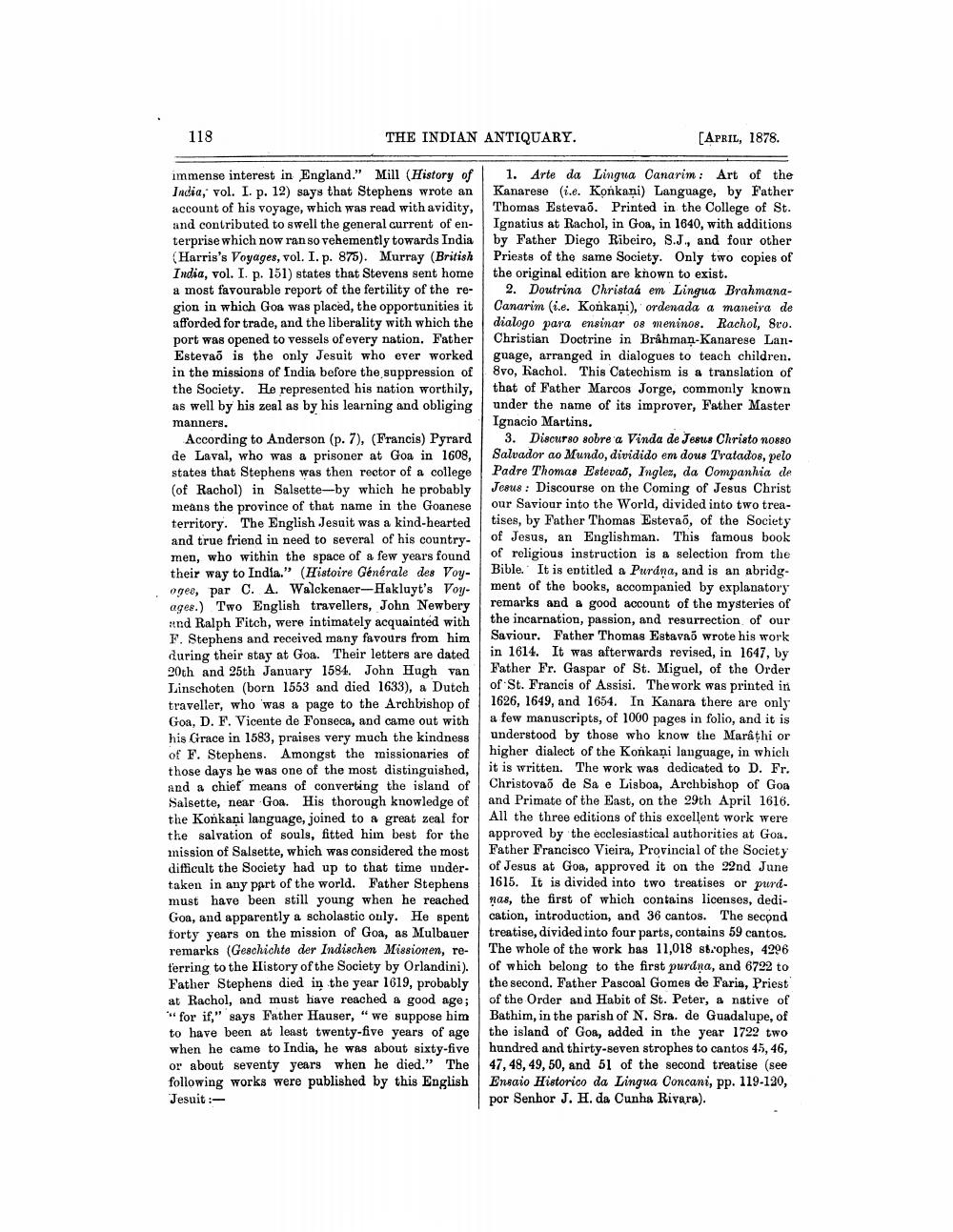________________
118
THE INDIAN ANTIQUARY.
[April, 1878.
immense interest in England." Mill (History of India, vol. I. p. 12) says that Stephens wrote an account of his voyage, which was read with avidity, and contributed to swell the general current of enterprise which now ran so vehemently towards India (Harris's Voyages, vol. I. p. 875). Murray (British India, vol. I. p. 151) states that Stevens sent home a most favourable report of the fertility of the region in which Goa was placed, the opportunities it afforded for trade, and the liberality with which the port was opened to vessels of every nation. Father Estevao is the only Jesuit who ever worked in the missions of India before the suppression of the Society. He represented his nation worthily, as well by his zeal as by his learning and obliging manners.
According to Anderson (p. 7), (Francis) Pyrard de Laval, who was a prisoner at Goa in 1608, states that Stephens was then rector of a college (of Rachol) in Salsette-by which he probably means the province of that name in the Goanese territory. The English Jesuit was a kind-hearted and true friend in need to several of his countrymen, who within the space of a few years found their way to India." (Histoire Générale des Voyoges, par C. A. Walckenger-Hakluyt's Voyagee.) Two English travellers, John Newbery und Ralph Fitch, were intimately acquainted with F. Stephens and received many favours from him during their stay at Goa. Their letters are dated 20th and 25th January 1584. John Hugh van Linschoten (born 1553 and died 1633), a Dutch traveller, who was a page to the Archbishop of Goa, D. F. Vicente de Fonseca, and came out with his Grace in 1583, praises very much the kindness of F. Stephens. Amongst the missionaries of those days he was one of the most distinguished, and a chief means of converting the island of Salsette, near Goa. His thorough knowledge of the Końkaņi language, joined to a great zeal for the salvation of souls, fitted him best for the mission of Salsette, which was considered the most difficult the Society had up to that time undertaken in any part of the world. Father Stephens must have been still young when he reached Goa, and apparently a scholastic only. He spent forty years on the mission of Goa, as Mulbauer remarks (Geschichte der Indischen Missionen, referring to the History of the Society by Orlandini). Father Stephens died in the year 1619, probably at Rachol, and must have reached a good age; *** for if," says Father Hauser, "we suppose him to have been at least twenty-five years of age when he came to India, he was about sixty-five or about seventy years when he died." The following works were published by this English Jesuit :
1. Arte da Lingua Canarim: Art of the Kanarese (i.e. Konkani) Language, by Father Thomas Estevao. Printed in the College of St. Ignatius at Rachol, in Goa, in 1640, with additions by Father Diego Ribeiro, S.J., and four other Priests of the same Society. Only two copies of the original edition are known to exist.
2. Doutrina Christaá em Lingua BrahmanaCanarim (ie. Konkani), ordenada a maneira de dialogo para ensinar 08 meninos. Rachol, 8vo. Christian Doctrine in Brâhman-Kanarese Language, arranged in dialogues to teach children. 8vo, Kachol. This Catechism is a translation of that of Father Marcos Jorge, commonly known under the name of its improver, Father Master Ignacio Martins.
3. Discurso sobre a Vinda de Jesus Christo nosso Salvador ao Mundo, dividido em dous Tratados, pelo Padre Thomas Estevaš, Inglez, da Companhia de Jesus : Discourse on the Coming of Jesus Christ our Saviour into the World, divided into two treatises, by Father Thomas Esterao, of the Society of Jesus, an Englishman. This famous book of religious instruction is a selection from the Bible. It is entitled a Purana, and is an abridg. ment of the books, accompanied by explanatory remarks and a good account of the mysteries of the incarnation, passion, and resurrection of our Saviour. Father Thomas Estavao wrote his work in 1614. It was afterwards revised, in 1647, by Father Fr. Gaspar of St. Miguel, of the Order of St. Francis of Assisi. The work was printed in 1626, 1649, and 1654. In Kanara there are only a few manuscripts, of 1000 pages in folio, and it is understood by those who know the Marathi or higher dialect of the Konkani language, in which it is written. The work was dedicated to D. Fr. Christovao de Sa e Lisboa, Archbishop of Goa and Primate of the East, on the 29th April 1616. All the three editions of this excellent work were approved by the ecclesiastical authorities at Goa. Father Francisco Vieira, Provincial of the Society of Jesus at Goa, approved it on the 22nd June 1615. It is divided into two treatises or puranas, the first of which contains licenses, dedi. cation, introduction, and 36 cantos. The second treatise, divided into four parts, contains 59 cantos. The whole of the work has 11,018 stophes, 4296 of which belong to the first purdna, and 6722 to the second. Father Pascoal Gomes de Faria, Priest of the Order and Habit of St. Peter, a native of Bathim, in the parish of N. Sra. de Guadalupe, of the island of Goa, added in the year 1729 two hundred and thirty-seven strophes to cantos 45, 46, 47, 48, 49, 50, and 51 of the second treatise (see Ensaio Historico da Lingua Concani, pp. 119-120, por Senhor J. H. da Cunha Rivara).




